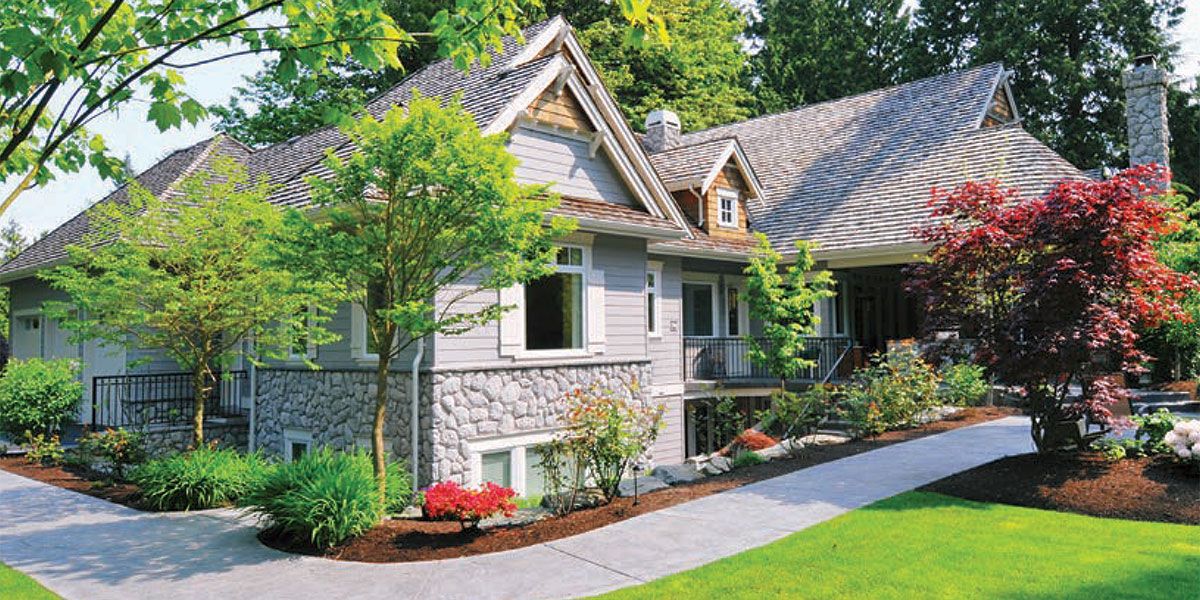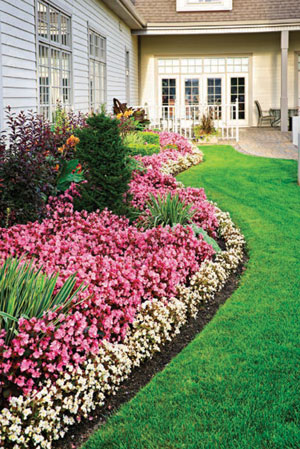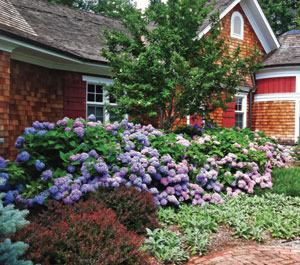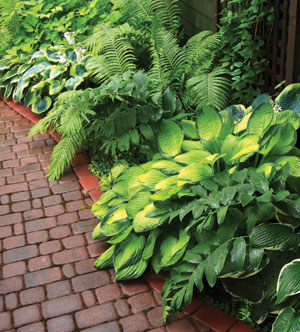Foundation Fundamentals | Set the Stage with Plants

Foundation plantings help anchor a house to the surrounding landscape, softening the edges of the structure while giving it a sense of belonging to the immediate terrain. Arguably an important part of the landscaping plan for your entire yard, foundation plantings can reflect the architectural style of the home while connecting it to the rest of your garden. A range of plantings, one that combines a variety of shrubs, flowers, groundcovers and small trees, makes for an interesting look.
 While many consider foundation plantings to be a row of identical shrubs planted in a straight line around a home, they can be so much more than that. They can be expanded into wider beds that offer a depth of plants, from standard evergreens to perennials and blooming shrubs, for a garden that changes with the seasons. Consider adding curves to these beds or enlarge them to connect to other features in your landscape. This not only gives the plants room to grow, it helps create visual flow, while centering the home in the surrounding landscape.
While many consider foundation plantings to be a row of identical shrubs planted in a straight line around a home, they can be so much more than that. They can be expanded into wider beds that offer a depth of plants, from standard evergreens to perennials and blooming shrubs, for a garden that changes with the seasons. Consider adding curves to these beds or enlarge them to connect to other features in your landscape. This not only gives the plants room to grow, it helps create visual flow, while centering the home in the surrounding landscape.
In creating a plan for your foundation garden, a good rule of thumb is to aim for roughly 50 percent evergreens, 25 percent flowering or deciduous shrubs, and 25 percent perennials. One approach is to consider evergreens the backbone of the garden, with shrubs and perennials filling in with seasonal interest. Yet even rhododendrons, azaleas and hollies are evergreens that offer pops of seasonal color with their blooms and berries. Small trees such as redbuds, dogwoods and Japanese maples can be incorporated, as well as hydrangeas prized for their flowers. Ground covers aren’t limited to creeping junipers or liriope; hellebores with their year-round foliage are an excellent choice for a foundation bed.
An important consideration for plants closest to your home is their size at maturity. Plants and shrubs should be in scale with the home they surround; elements that are under- or oversized can throw the entire look out of whack. You’ll need to plan for both the height and width of a plant, ensuring an evergreen planted below a window doesn’t grow large enough to block it while the roots grow into the foundation. Generally, use half the expected mature spread of the plant for determining the planting distance; for example, a bush that could grow 8 feet wide should be planted 4 feet from the house. You’ll also want to make sure there is ample room between your plantings and the house so you can have access for maintenance.
 Create focal points by using features of the house as “moments” to be designed around—like the front door. In a more formal, Georgian-style home, boxwoods on either side of the front door offer a classic, symmetrical balance that flatters the style of the house. Meanwhile, hydrangeas flanked by hostas in the same spot on a Cape Cod-style home lend a cozy, casual feel. Other focal points could be a stretch of bare wall between windows, or the area surrounding a chimney. Here, taller shrubs, small trees or even a trellis can be installed to give the eye something to admire. The corners of your home are another good spot for taller anchor plants, which act to tie the house into the landscape and can help make the smallest houses appear bigger.
Create focal points by using features of the house as “moments” to be designed around—like the front door. In a more formal, Georgian-style home, boxwoods on either side of the front door offer a classic, symmetrical balance that flatters the style of the house. Meanwhile, hydrangeas flanked by hostas in the same spot on a Cape Cod-style home lend a cozy, casual feel. Other focal points could be a stretch of bare wall between windows, or the area surrounding a chimney. Here, taller shrubs, small trees or even a trellis can be installed to give the eye something to admire. The corners of your home are another good spot for taller anchor plants, which act to tie the house into the landscape and can help make the smallest houses appear bigger.
 When planning your foundation plantings, take a picture of your home. Enlarge it and trace it onto paper, keeping the elements in place that you like. From here, you can sketch in plants you’d like to consider (in their full-grown shape and size) to determine exactly how much you can incorporate into your garden. As you consider plants, keep in mind the exterior color scheme of your home. You’ll want your foundation plantings to echo that color scheme to some extent, as it helps create a sense of unity between your home and its surroundings. A unified color scheme of purple blooming plants with a red door creates a fun contrast against the background greens of larger evergreen shrubs. Don’t forget to keep some negative space; those intentional empty spots between plantings help a space seem less cluttered. When layering plantings, approach it like you would a family photo: shortest in front, tallest in back to avoid plants getting lost or overpowered. As you mix perennials in, keep in mind that an assortment of spring and summer bloomers will ensure color and fresh blooms all season long. The early-blooming daffodils and tulips will fade, making room for a late-blooming coneflower.
When planning your foundation plantings, take a picture of your home. Enlarge it and trace it onto paper, keeping the elements in place that you like. From here, you can sketch in plants you’d like to consider (in their full-grown shape and size) to determine exactly how much you can incorporate into your garden. As you consider plants, keep in mind the exterior color scheme of your home. You’ll want your foundation plantings to echo that color scheme to some extent, as it helps create a sense of unity between your home and its surroundings. A unified color scheme of purple blooming plants with a red door creates a fun contrast against the background greens of larger evergreen shrubs. Don’t forget to keep some negative space; those intentional empty spots between plantings help a space seem less cluttered. When layering plantings, approach it like you would a family photo: shortest in front, tallest in back to avoid plants getting lost or overpowered. As you mix perennials in, keep in mind that an assortment of spring and summer bloomers will ensure color and fresh blooms all season long. The early-blooming daffodils and tulips will fade, making room for a late-blooming coneflower.
 Foundation plantings are an important element of your home’s exterior appearance and shouldn’t be overlooked. As with any garden, a mix of plantings with different colors and textures offers a far more welcoming appearance than a uniform row of formal shrubs. With just a little planning, it’s quite easy to make the outside of your home just as cozy and cheerful as it is on the inside by considering the plants around the foundation. ✦
Foundation plantings are an important element of your home’s exterior appearance and shouldn’t be overlooked. As with any garden, a mix of plantings with different colors and textures offers a far more welcoming appearance than a uniform row of formal shrubs. With just a little planning, it’s quite easy to make the outside of your home just as cozy and cheerful as it is on the inside by considering the plants around the foundation. ✦
azaleas, color scheme, Colors, deciduous shrubs, dogwoods, Evergreens, flowers, Foundation Plantings, Ground covers, groundcovers, hollies, Japanese maples, Perennials, redbuds, rhododendrons, shrubs, small trees, textures






